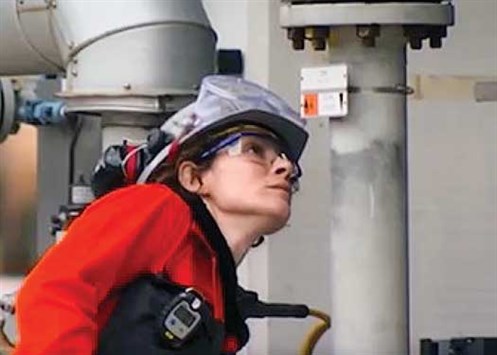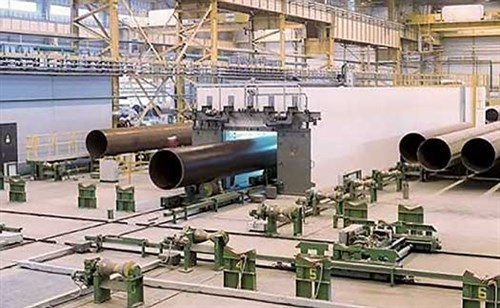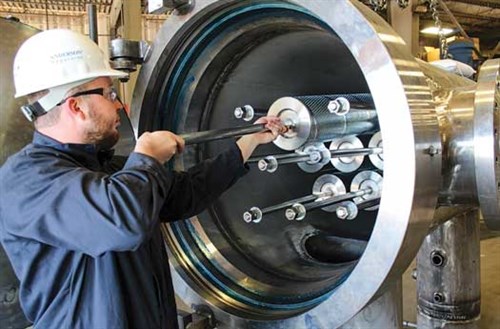New in gas processing technology
B. Andrew, Technical Editor
Predictive corrosion management tool
 |
GE Oil & Gas has launched Predictive Corrosion Management, a digital inspection solution for industrial assets, such as refinery pipes. This new Asset Performance Management (APM) solution uses embedded sensors to provide continuous inspection data and cloud-based analytics of pipe conditions to help operators manage risk, improve uptime and minimize total cost of operations.
At present, corrosion is estimated to cost $2.2 T, or approximately 3.5% of global GDP, according to NACE International. Corrosion alone costs the refining industry approximately $6 B/yr. Additionally, refineries face multiple threats of shutdown due to inspection, maintenance and repair; a refinery shutdown can cost up to $1 MM/d.
Predictive Corrosion Management (PCM) uses GE’s Rightrax installed ultrasonic sensors with the Predix cloud-based operating system and advisory services. This package allows for continuous collection and analysis of real-time performance data, as well as monitoring of corrosion-related risk, so that facilities can proactively make disposition decisions, enabling digital inspection of pipes. While GE is initially launching the tool in a downstream application, the solution applies across the midstream value chain, including pipelines, nuclear plants and other facilities.
This continuous inspection tool can identify corrosion before it becomes a problem. It can also improve the reliability of inspection data, remove manual inconsistencies and enable customers to model and predict piping failures due to corrosion and erosion, which extend the run life of pipes and other fixed assets.
PCM is said to help reduce operational blind spots, as well as inspection labor. Another aspect to consider is the aging workforce in the North American oil and gas industry. As more technicians and engineers retire, it becomes harder to retain the operational knowledge that goes out the door. Building out an analytical tool that can capture the corrosion knowledge in analytical models is a great risk mitigation tool for the current demographics of the industry.
www.ge.com/digital/products/predictive-corrosion-management
X-ray inspection of pipelines
 |
Demanding international standards for pipeline safety require 100% quality inspection of the welding lines. During the welding process, a broad variety of defects can occur, such as porosities or cracks. An undiscovered failure can lead to severe consequences and liability charges for manufacturers. Therefore, it is necessary to inspect welding lines on pipes and tanks through extensive non-destructive testing (NDT).
Over decades, these tests have been performed via analogue technique, by exposing X-ray films. In the last 10 yr–15 yr, it has become more common to use digital radiography (DR). This modern approach helps achieve quality control and safety requirements, while providing cost reduction through a high degree of automation.
VisiConsult X-ray System & Solutions GmbH has developed a new setup incorporating high-tech materials for digital flat panels. Instead of using a massive steel boom, a carbon fiber tube is used. The weight of the tube is less than 100 kg, which yields a large, stable lifting device. It also allows innovative cooling systems to operate on the inside. This results in a lighter setup, longer detector lifetime and faster operation principle.
Multi-gas safety sensor with Bluetooth alarms
MSA’s ALTAIR 4XR Multigas Detector provides real-time event notification using Bluetooth connectivity. The four-gas monitor, which includes proven MSA XCell Sensors, is said to be among the fastest in the world. Paired with MSA’s ALTAIR Connect app, it can text alarm notifications to personnel.
Filter elements provide safer changeouts
 |
Clark-Reliance Corp. has announced a new line of coalescing filter elements for the gas processing industry. The new VertexCore filter elements have been designed to eliminate unsafe filter element changeout techniques while increasing filtration efficiencies.
VertexCore elements have a fixed extension that is welded to the element end cap, which allows maintenance staff to easily remove and replace elements without exposing their head, shoulders, torso or legs to a confined space. This design feature eliminates the widespread behavior of climbing into or reaching into filtration pressure vessels to remove or replace elements. The VertexCore extensions and hold down rods, while facilitating element replacement, also provide a barrier to prevent operator entry, a positive reinforcement to confined space safety regulations.
VertexCore coalescing filter elements feature multi-layer construction to maximize efficiency, with third-party testing confirming that they meet ANSI/CAGI 400 test standards. Removal efficiencies are down to 0.3 micron at 99.98%, with maximum carryover of 0.1 ppmw. As they are more efficient, VertexCore elements can be retrofitted to existing pressure vessels to eliminate carryover created by the inadequate element spacing of standard elements.
VertexCore coalescing filter elements are designed for critical-use applications in the power generation, oil and gas, and other industries.
crfiltrationsolutions.com/vertexcore/




Comments